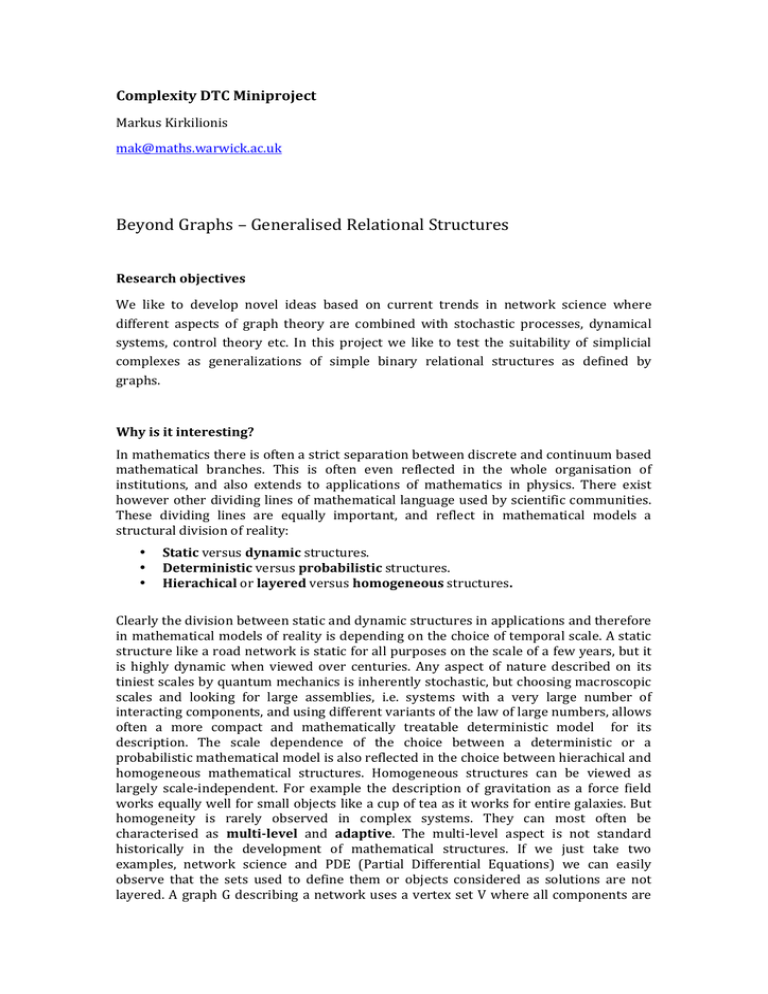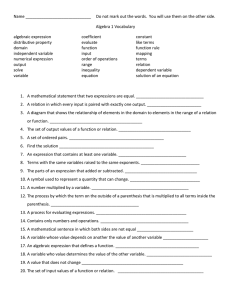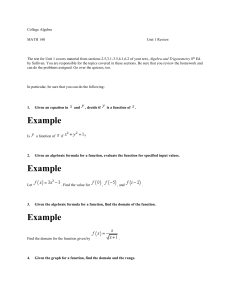Document 13294256
advertisement

Complexity DTC Miniproject Markus Kirkilionis mak@maths.warwick.ac.uk Beyond Graphs – Generalised Relational Structures Research objectives We like to develop novel ideas based on current trends in network science where different aspects of graph theory are combined with stochastic processes, dynamical systems, control theory etc. In this project we like to test the suitability of simplicial complexes as generalizations of simple binary relational structures as defined by graphs. Why is it interesting? In mathematics there is often a strict separation between discrete and continuum based mathematical branches. This is often even reflected in the whole organisation of institutions, and also extends to applications of mathematics in physics. There exist however other dividing lines of mathematical language used by scientific communities. These dividing lines are equally important, and reflect in mathematical models a structural division of reality: • • • Static versus dynamic structures. Deterministic versus probabilistic structures. Hierachical or layered versus homogeneous structures. Clearly the division between static and dynamic structures in applications and therefore in mathematical models of reality is depending on the choice of temporal scale. A static structure like a road network is static for all purposes on the scale of a few years, but it is highly dynamic when viewed over centuries. Any aspect of nature described on its tiniest scales by quantum mechanics is inherently stochastic, but choosing macroscopic scales and looking for large assemblies, i.e. systems with a very large number of interacting components, and using different variants of the law of large numbers, allows often a more compact and mathematically treatable deterministic model for its description. The scale dependence of the choice between a deterministic or a probabilistic mathematical model is also reflected in the choice between hierachical and homogeneous mathematical structures. Homogeneous structures can be viewed as largely scale-­‐independent. For example the description of gravitation as a force field works equally well for small objects like a cup of tea as it works for entire galaxies. But homogeneity is rarely observed in complex systems. They can most often be characterised as multi-­level and adaptive. The multi-­‐level aspect is not standard historically in the development of mathematical structures. If we just take two examples, network science and PDE (Partial Differential Equations) we can easily observe that the sets used to define them or objects considered as solutions are not layered. A graph G describing a network uses a vertex set V where all components are inherently of the same category, i.e. on the same level of a potential hierarchy (like only persons, but not persons and institutions). The solution of a PDE is a continuum distribution over its domain of definition -­‐ which usually is a homogeneous set, i.e. containing no ‘special’ points or sub-­‐manifolds of different dimension that would describe ‘special’ discrete objects etc. In order to develop a new mathematical framework for multi-­‐level complex systems we need to review and combine several branches of mathematics: • • Graph Theory (Network Science). Graph theory builds currently in many respects the fundamentals of complex systems theory. Due to the simple and manifold interpretation of graphs just describing the (ordered (directed) or un-­‐ ordered (un-­‐directed)) relationships between objects or system components they have indeed a wide range of application. We need to investigate how multi-­‐ level system characteristics can be best incorporated into existing graph theory, or generalised with the help of other mathematical areas, like algebraic topology. The figure shows an example of a co-­‐authorship network. (FromVisual Complexity website). Category Theory. Category theory is important for the development of any mathematical framework, as it can describe mathematical structures in a fundamental way based on objects and mappings between objects. Category theory can often be used to show the structural equivalence between mathematical frameworks. Figure: A pull-­‐back category. • Algebraic Topology. Algebraic topology has been formulated to investigate fundamental invariants (invariant under continuous transformation) of geometrical objects. It has developed a rich tool set of mathematical methods to achieve this goal which can be used in many other contexts. An important role for the whole project will be played by simplicial complexes. The reason is that they can be used to define natural hierachical extensions to the graph theory language, i.e. of relationships between objects. Figure: A simplicial complex. • Algebraic Geometry. We will use a variety of algebraic methods developed inside algebraic geometry. For example we will use monomial calculus, and respective computations of Gröbner basis. This turns out to be very efficient and powerful for solving real world problems where the mathematical model describing the phenomenon has some kind of polynomial structure. This can go as far as application to polynomial differential equations describing chemical reaction systems inside the mass action formalism. • Stochastic Processes. Most complex systems are stochastic, and therefore need to be described via the formalism of stochastic processes. For example in network science one can make a transition from a static graph to a graph where edges and vertices are formed or annihilated due to a random process over time. A PDE can be generalised to a stochastic PDE. In so-­‐called agent-­based modelling which is discrete event based, the events themselves are described by a stochastic process taking into account the interaction between agents. Much work has been done on discrete random processes defined on (regular) lattices. In this work package stochastic processes on both discrete and continuum structures will be considered. Figure: A stochastic process defined on a regular lattice. Techniques required. - Graph theory - Combinatorics - Algebraic Topology - Stochastic Processes Prospective deliverables. - Building blocks and concepts to understand higher order relational structures. - A small example of an opinion formation process defined on simplicial complexes. Who should benefit from this research? - All complex systems scientists - Economists, social scientists. - Epidemiologists Outline of avenues for a follow-­up PhD project. The project has potential for several PhD so a thesis must focus on some aspect of this research. A very fruitful research direction is to introduce a simple opinion formation process on simplicial complexes to test the ideas in practice. References: - Most books on Algebraic Topology (contact proposer) - Literature on Opinion Formation Models (contact proposer)






